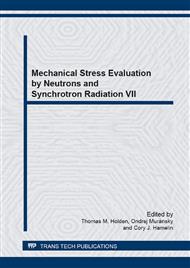p.205
p.213
p.219
p.225
p.231
p.237
p.243
p.249
p.255
Residual Stresses Distribution Measured by Neutron Diffraction in Fabricated Square High Strength Steel Tubes
Abstract:
Engineers are increasingly encouraged to consider sustainability in the design and construction of new civil engineering infrastructure. Sustainability can be achieved through the use of high strength materials thereby reducing quantity of materials required in construction where possible. Knowledge of residual stresses in fabricated columns is important in identifying whether the fabricated columns can be classified as heavily welded (HW) or lightly welded (LW). The determination of residual stresses can be used to determine the local buckling of stub columns. Residual stress magnitudes are also essential in the numerical modelling of buckling behaviour of columns. This paper outlines the challenges in measurement of residual stresses using neutron diffraction in fabricated high strength steel square tubes. The residual stress line scans and maps were measured using the Kowari Strain Scanner located at the Australian Nuclear and Science Organisation (ANSTO) in Australia.
Info:
Periodical:
Pages:
249-254
Citation:
Online since:
February 2014
Price:
Сopyright:
© 2014 Trans Tech Publications Ltd. All Rights Reserved
Share:
Citation:


